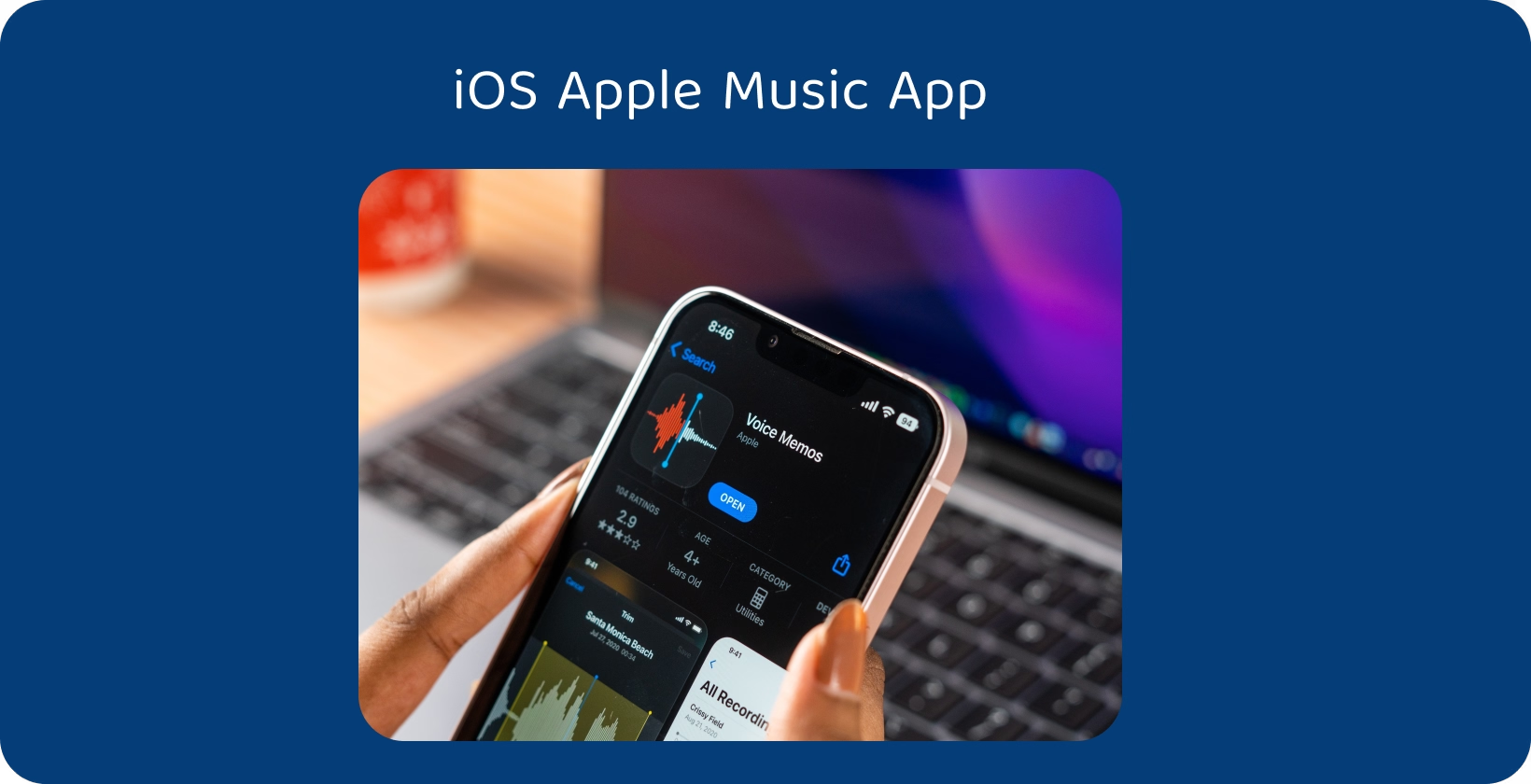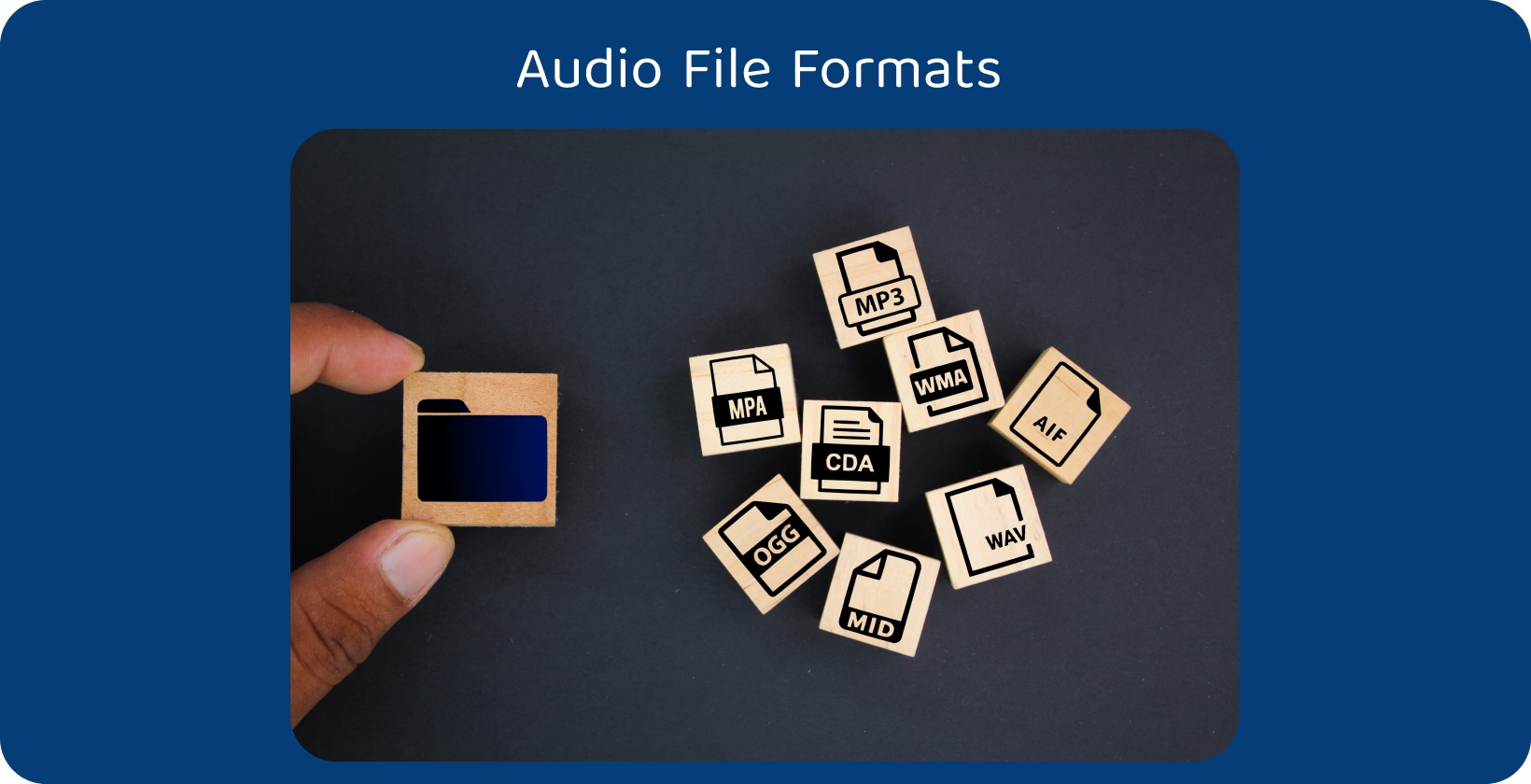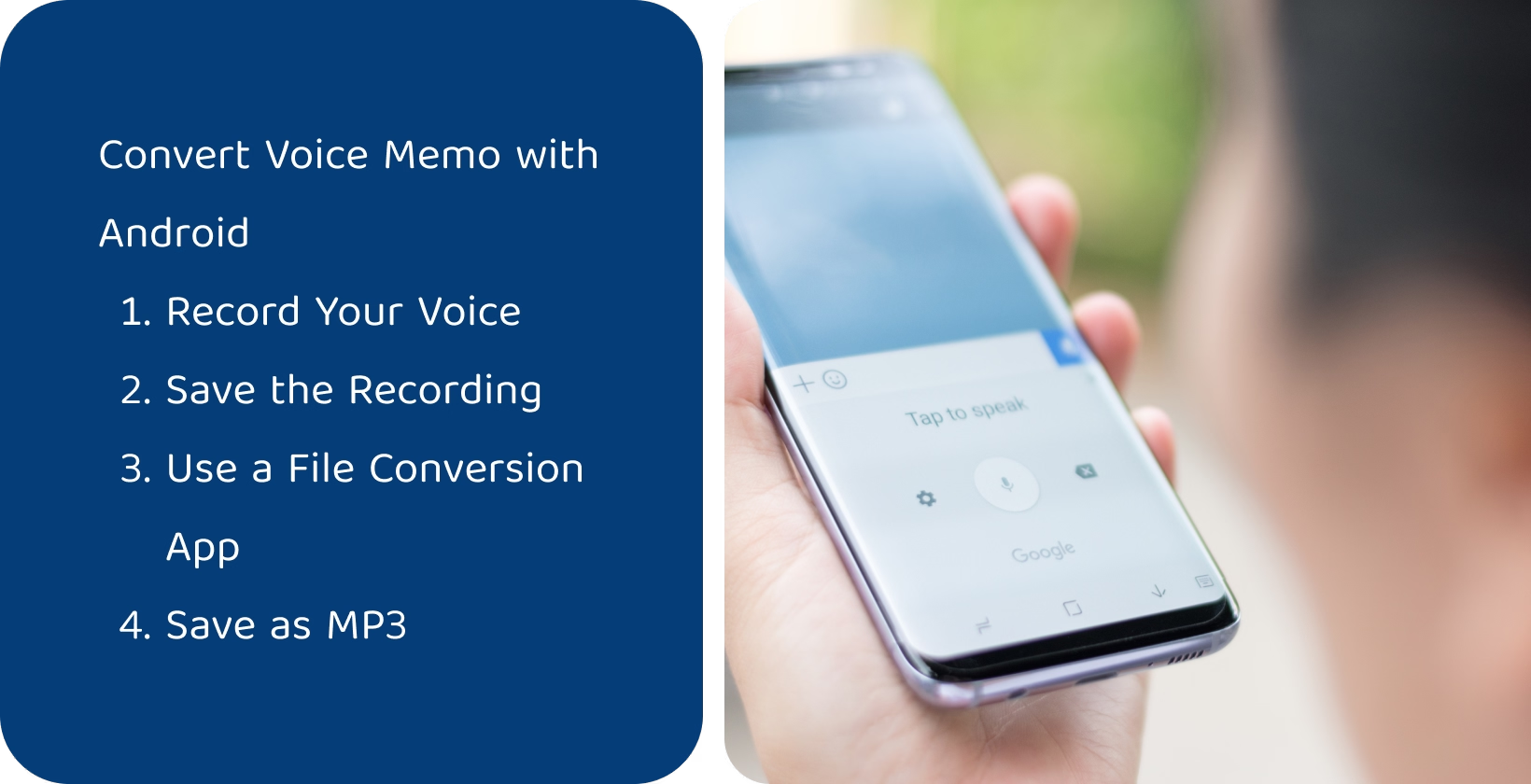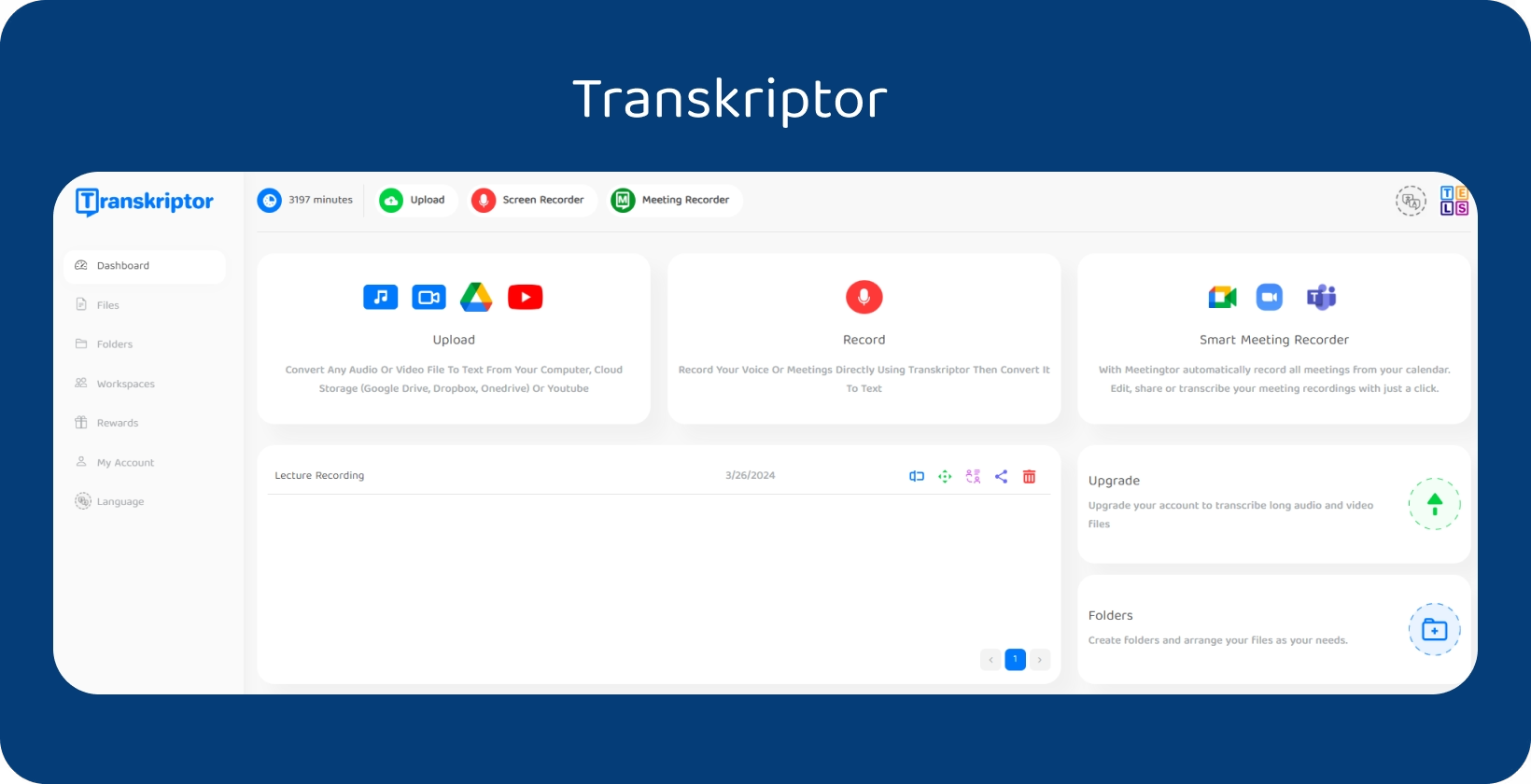A voice memo is a digital audio recording on mobile devices. Voice memo allows users to record spoken dialogues, lectures, or interviews. Voice memos document meetings, create voice reminders, and capture ideas. Users save, share, and convert the audio format to meet their needs and desires.
MP3 files are compatible with a wide range of devices and softwares. People commonly use the MP3 format for listening to music, podcasts, and audiobooks. Smartphones, computers, and MP3 players play MP3 format.
Transkriptor is an invaluable tool in this context, streamlining the conversion process from voice memos to text and then to MP3 format, significantly enhancing research productivity by allowing researchers to easily transcribe and organize their audio data. It automates transcription, making it simpler for users to convert their recordings into editable, shareable text before finalizing them in the universally compatible MP3 format.
The 4 ways to convert voice memo to MP3 are listed below.
- Using iOS Apple Music App: The method involves using the Apple Music app on your iOS device. First, you need to save your voice memo.
- Using Free Audio Converter Mobile App: The apps allow users to import voice memos and then convert them into MP3 format directly on their mobile device.
- Using Desktop Software Audio Converter: The method is often preferred for its higher conversion quality and additional features.
- Using Online Converter: The method is convenient and quick, but using an online converter requires a stable internet connection and may have limitations on file size or number of conversions.

1. Using iOS Apple Music App
Open the “Voice Memos” app on the iOS device. Choose the voice memo to convert to MP3 format from the list of recorded memos. Tap the share button at the bottom of the screen. The share button is usually an arrow or a box with an arrow pointing up.
Select “Save to Files” in the sharing options. Saving to files will save the voice memo as an audio file. Select the location on the device to save the file. Click “Save” to save the voice memo. The audio file will be with the .m4a extension.
Go to the “Apple Music” app on the iOS device. Navigate to the library in the Apple Music app. Find the saved voice memo file. Tap on the voice memo to select it. Tap the three dots icon and select “Create AAC Version”. This will convert the voice memo into an AAC file.
Locate the AAC file in the music library. Rename and change the file extension to convert the AAC version into MP3 file format.
The Apple Music app offers accessibility, integration, and no additional costs. The iOS Apple Music app integrates with the Voice Memos app and it is easy to manage. Apple users do not pay additional costs for using the app.
2. Using Free Audio Converter Mobile App
Go to Google Play Store for Android or Apple App Store for iOS. Search for the free audio converter mobile app and download it. Launch the audio converter app. Find the option to import or add files to the app.
Select the voice memo to convert it into MP3. Choose the output format as MP3 file format. Adjust the bitrate, sample rate, or other audio quality parameters if they are available. Start the conversion process. Save the MP3 file on the device after the conversion finishes. In this context, the Transkriptor mobile application offers a unique advantage by providing transcription services directly from a user's mobile device.
Converting voice memos to MP3 using a free mobile app has pros. These include no need for a computer, various output formats, and portability. Users do not need to access a computer to complete the conversion. Audio converter mobile apps provide various formats to convert voice memos. People easily share or play the converted MP3 files on a mobile device.
The cons are app limitations and internet dependency. Free apps have limited features or restrictions on the number of conversions users perform. Most of the mobile apps for conversion require a stable internet connection.
3. Using Desktop Software Audio Converter
Go to the official website of a desktop audio converter software such as Audacity or Freemake Audio Converter. Download the software installer for the operating system. Install the software by following the on-screen instructions.
Launch the audio converter software. Find the import or add files option on the software. Locate the output format settings and choose MP3 file format.
Arrange the bitrate, sample rate, or other quality parameters within the software. Initiate the conversion process by clicking the “Convert” or “Start” button. The software will convert the voice memo to MP3. Open and save the MP3 file on the computer when the conversion is completed. In the context of using desktop software for audio conversion, Transkriptor offers an advanced solution for converting audio files into different formats.
The pros of using desktop software audio converter to convert voice memos to MP3 are advanced customization, high-quality conversion, and no internet dependency. Desktop software offers a wide range of customization options for audio settings.
The cons are computer requirements, potential cost, and device storage. Users need a functioning computer to use the desktop software. Advanced or premium desktop software requires additional costs while there are free desktop software options. Desktop software occupies a significant storage space on the computer’s hard drive.
4. Using Online Converter
Find a reliable online converter and open the website of the chosen online converter. Find the option to upload or select the voice memo file. Click on the “Choose File” or “Select” button. Navigate to the location of the voice memo file on the computer or mobile device.
Select “MP3” as the desired output format for the conversion. Adjust the audio settings if needed.
Initiate the conversion process by clicking the “Convert” or “Start” button on the website. The online converter will process the voice memo and convert it to MP3. The converter will provide a download link for the converted MP3 file.
Click the link to download the MP3 file to the computer or device. Access and play the MP3 file in the device’s built-in media player or any other audio player app.
The pros of using an online converter to convert voice memos to MP3 are platform independence, no local storage requirements, and a wide range of options. Online converters function on various operating systems such as Windows, macOS, and Linux. Users do not need to worry about saving or managing software or files on the local device because the conversion process happens in the cloud. Using an online converter provides numerous options and each of them offer various output formats, audio quality settings, and additional features.
The cons are internet dependency, privacy concerns, and ads. Online converters rely on a stable internet connection. Slow or unstable internet connections lead to interruptions. Free online converters are ad-supported and users encounter pop-up ads or banner ads during the conversion process.
While online converters provide a flexible solution for converting voice memos to MP3, Transkriptor adds another layer of functionality for those looking to transcribe their audio files into text. As a complement to online conversion tools, Transkriptor offers advanced transcription services that turn spoken words into accurate written formats, making it an essential tool for professionals requiring both audio conversion and text documentation
Why Do Audio File Formats Matter?
Audio file formats matter because the compatibility, file size, sound quality, and editing aspects vary according to file formats. Different devices and software support different audio formats. Choosing the right file format increases the compatibility of the audio files .
Audio file formats vary significantly in terms of file size. Choosing a more efficient format helps users to save storage on their devices and reduces the data usage.

What are Different Audio File Formats?
The different audio file formats are listed below.
- MP3 (MPEG-1 Audio Layer 3): MP3 is one of the most widely used audio formats. MP3 offers high sound quality and is suitable for music, podcasts, and other audio playbacks.
- WAV (Waveform Audio File Format): WAV files are uncompressed files and offer high-quality audios. WAV files are suitable for professional audio production.
- FLAC (Free Lossless Audio Codec): FLAC is a lossless audio format and preserves the original audio quality without compression. FLAC is popular among audiophiles.
- ACC (Advanced Audio Coding): AAC is a high-quality compression file type. People commonly use ACC on Apple’s iTunes and devices. ACC offers high sound quality audio.
- OGG (Ogg Vorbis): OGG is an open-source audio format. OGG offers good compression and sound quality. People commonly use OGG for streaming.
- WMA (Windows Media Audio): WMA is a proprietary audio format by Microsoft. WMA offers good compression. WMA is compatible with Windows-based devices and software.
Lossy formats offer efficient compression. Audio quality varies according to the bitrates. MP3 file format is one of the lossy formats. Specialized formats offer variable quality depending on the format choice.
How to Convert Voice Memo to MP3 Using iPhone?
Follow the steps below to convert voice memo to MP3 using iPhone.
- Open Voice Memos App. Locate and open the Voice Memos app on your iPhone . It is a built-in application identifiable by its red waveform icon.
- Record Your Voice Memo. Tap the red record button at the bottom of the screen to start recording your voice memo. Speak clearly into the microphone.
- Save the Recording. After stopping the recording, a prompt will appear to save the memo. Tap "Done," then enter a name for the recording and save it.
- Share the Voice Memo. Find the recording in the list of voice memos. Tap on it to open, then select the three dots or 'More' button to access additional options. Choose "Share" from this menu.
- Use a Third-Party App for Conversion. Users need a third-party app since iOS doesn't natively support MP3 conversion. There are several available on the App Store.
- Convert and Save as MP3. Open the third-party app and import the voice memo you shared. Follow the app's instructions to convert the file to MP3 format.

How to Convert Voice Memo to MP3 Using an Android Phone?
Follow the steps below to convert voice memo to MP3 using Android phone.
- Open Voice Recorder App. Locate and open the default voice recorder app on the Android phone.
- Record Your Voice Memo. In the voice recorder app, tap the record button to start recording the voice memo.
- Save the Recording. Enter a name for your voice memo and save it.
- Locate the Saved Recording. Go to the app's recording list or the phone's file manager to find the saved voice memo.
- Use a File Conversion App. Users need a file conversion app to convert it to MP3 since most voice memos are saved in formats like WAV or AMR. Download a reliable audio converter app from the Google Play Store.
- Convert and Save as MP3. Open the audio converter app and import the voice memo file. Select MP3 as the output format and start the conversion.
How to Convert Voice Memo to MP3 Using Windows?
Follow the steps below to convert voice memo to MP3 using Windows.
- Transfer the Voice Memo to Your Computer. Connect the device (iPhone or Android) to the Windows computer using a USB cable. Access the device's storage and locate the voice memo file. Or use the recording feature of Windows.
- Download an Audio Conversion Software. There are many free options available like Audacity, Freemake Audio Converter, or Format Factory. Download and install one of these programs.
- Open the Audio Conversion Software. Launch the audio conversion software you installed.
- Import the Voice Memo File. Look for an option to 'Import', 'Open', or 'Add File' and select the voice memo file in the audio converter.
- Select MP3 as the Output Format. Look for an option to choose the output format. Select 'MP3' from the list of available formats after selecting MP3 as the output format.
- Convert and Save the File. Click on the 'Convert', 'Export', or 'Save' button -the exact wording may vary depending on the software- after selecting MP3 as the output format. Save the new MP3 file on the computer and start the conversion process.
How to Convert Voice Memo to MP3 Using Mac?
Follow the steps below to convert the voice memo to MP3 using Mac.
- Open the Voice Memos App. Find and open the Voice Memos app on your Mac. It is also possible to use the recording feature of Mac.
- Select the Voice Memo. Click on the voice memo you want to convert in the Voice Memos app.
- Export the Voice Memo. Click on 'File' in the menu bar, then choose 'Export' with the memo selected.
- Save the File in an Accessible Format. Choose a location to save the file and select 'AAC' as the format in the export window, which is a widely supported format and a step towards converting it to MP3.
- Open the File in an Audio Converter. There are several free options available online, such as Audacity or online converter tools. Download and open the chosen software, then import the AAC file.
- Convert and Save as MP3. Select MP3 as the output format and choose the desired quality settings in the audio converter. Then, start the conversion process.

Converting Voice Memos to Text with Transkriptor
Transforming voice memos into text has never been easier. Transkriptor caters to the needs of users who seek to leverage their voice recordings for various purposes, from creating documentation to sharing insights in a more accessible format.
- Step 1: Sign Up or Log In to Transkriptor: Begin by accessing Transkriptor. Its user-friendly platform allows for quick sign-up or login, streamlining the process to convert your voice memos.
- Step 2: Upload Your Voice Memo: Upload the voice memo you intend to transcribe. Transkriptor's compatibility with multiple audio formats ensures a hassle-free upload process, accommodating recordings from different devices.
- Step 3: Transcription Process: With your audio file uploaded, initiate the transcription. Transkriptor employs state-of-the-art AI to deliver accurate text renditions of your voice memos, capturing the essence of your recordings with remarkable precision.
- Step 4: Review and Edit: Review the generated transcription within Transkriptor's editing interface. This allows for any necessary corrections or adjustments, ensuring the text accurately represents your audio content.
- Step 5: Convert to MP3: After fine-tuning the transcription, Transkriptor facilitates the conversion of your edited text back into an MP3 format. This feature is particularly beneficial for creating accessible audio content from text-based information.
Try it now!


